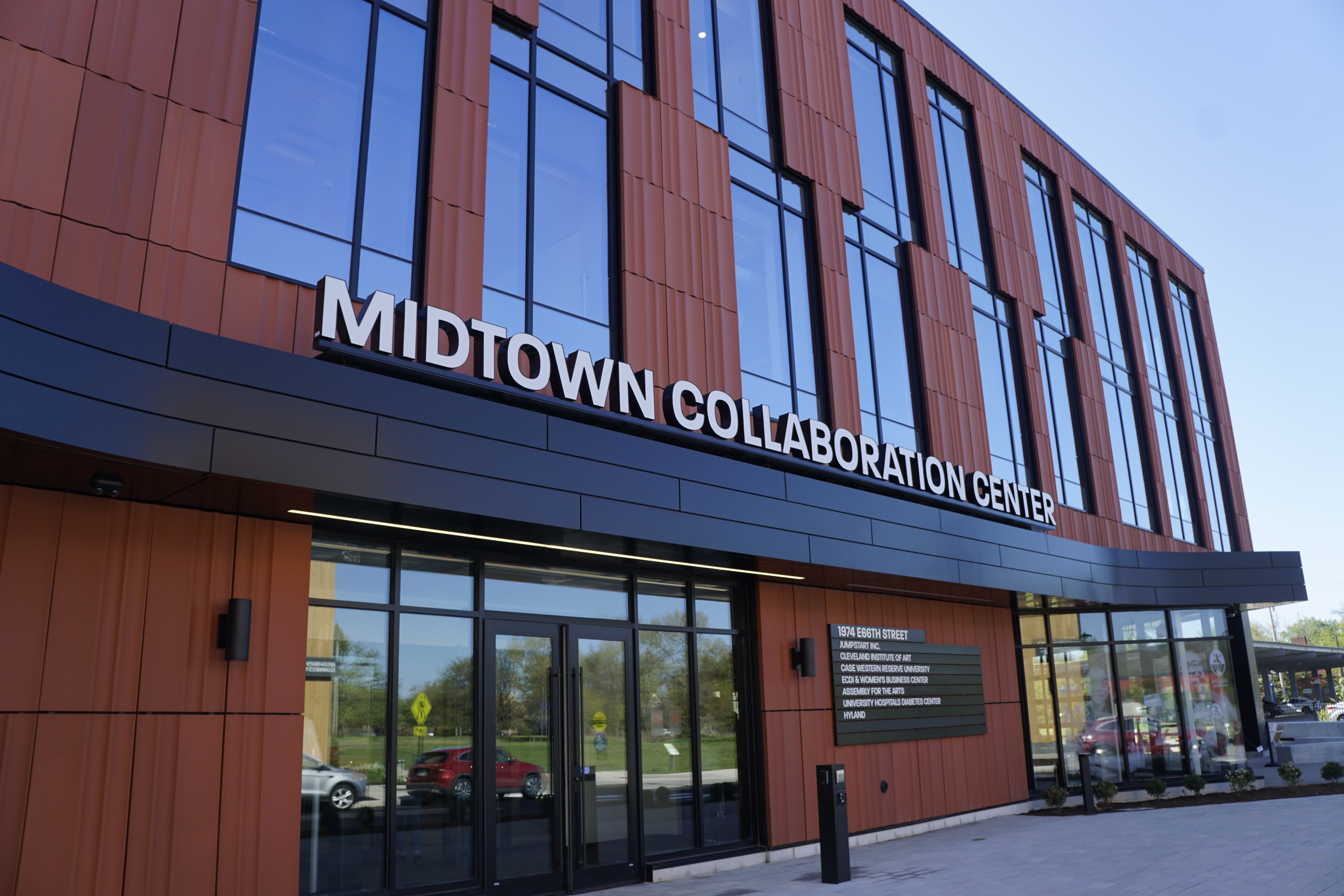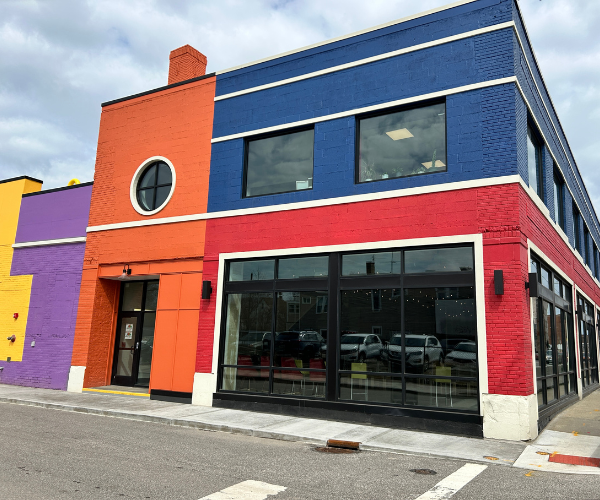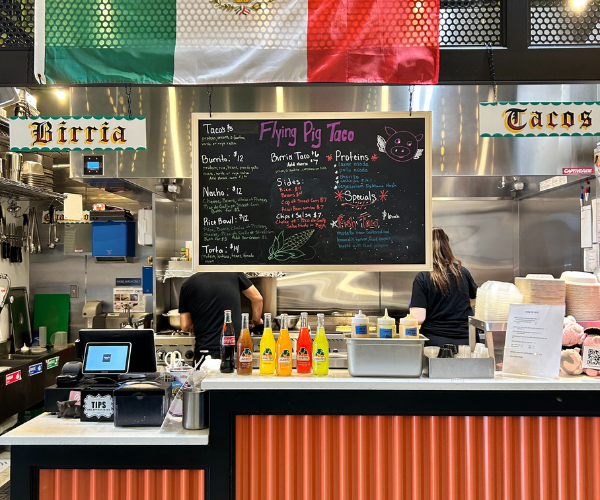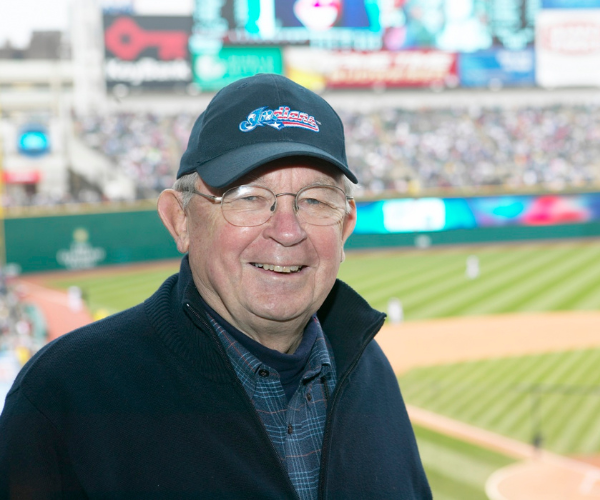Danielle Sydnor Advocates For Change
by Candice Wilder | Aug. 31, 2020 | 12:00 PM

(PHOTOS: ANGELO MERENDINO, ERNEST HATTEN, KAMRON KHAN PHOTOGRAPHY, AMINAH VARGAS)
Editor’s note: This feature, which appears in our September issue, was written before the Aug. 23 police shooting of Jacob Blake in Kenosha, Wisconsin.
Danielle Sydnor didn’t watch the video of George Floyd’s death. It was too much grief to take in, seeing the 46-year-old Black father of five pleading for air as Minnesota police officer Derek Chauvin kneeled on his neck for eight minutes and 46 seconds.
“There aren’t a lot of things that get me worked up,” she says, “but this is just another situation where a Black man’s life was taken in a very callous way.”
For Sydnor, a mother of two young Black men and the president of NAACP Cleveland, the hatred and violence toward Black people have become a spectacle of pain and torment in a world that continues to casually view and rationalize their deaths. The reality that her family, friends and neighbors could be harmed continues to shape her worldview.
“These are real people. This is real life pain and suffering. I wouldn’t want my son’s images to be all over the internet on repeat for people who care less about his Black body,” says Sydnor. “I won’t subject myself to the trauma of seeing someone slain and see people justify why they were murdered.”
Sydnor has seen this too many times in Cleveland.
In 2012, Timothy Russell and Malissa Williams were killed by six Cleveland police officers who shot 137 bullets into their car after a lengthy high-speed chase.
In 2014, 12-year-old Tamir Rice was playing outside with a toy gun when he was killed by police officer Timothy Loehmann.
And on April 9, Desmond Franklin, a 22-year-old Black father of four, was fatally shot in the head by off-duty Cleveland police officer Jose Garcia.
It was the culmination of these incidents that compelled Sydnor to show up with members of her executive committee for the Black Lives Matter Cleveland protest downtown on May 30. The event was one of several mass uprisings happening across the nation this summer demanding justice for the Black community.
So Sydnor stood vigilant in a crowd of thousands, listening attentively to a long list of frustrations and speeches spoken over bullhorns and megaphones. As the crowd marched toward the Cuyahoga County Justice Center, Sydnor held up her fists and joined in the chants of “No Justice, No Peace,” “I Can’t Breathe” and “Hands Up, Don’t Shoot.”
“It’s important that in these moments where we are calling for justice, we show up and demonstrate the power of community, to organize together,” says Sydnor.
But when the peaceful protest began to unravel — with police using tear gas canisters to disperse the crowd and protestors setting fire to two police vehicles — Sydnor left before the situation turned volatile and continued throughout the night.
“The tension is there because voices are not being heard,” she says. “They have been beating the drum for way too long and no one seems to be paying attention.”

As the first woman to be elected as Cleveland’s NAACP president since 1982, Sydnor is adamant about keeping the organization close to its foundational mission.
Founded in 1909 to organize equal rights for Black people in response to lynchings and race riots around the country, the NAACP remains one of the oldest and most preeminent civil rights organizations in the nation. The Cleveland chapter, founded in 1912, continues to work on eliminating racial discrimination and ensuring political, educational, social and economic opportunities for all. Since becoming president, Sydnor has been especially focused on advancing financial equality for Black residents by participating in civic and service activism coupled with a push for legislative policy reform. To formulate real change, Sydnor believes that it’s not enough to call attention to the atrocities that are happening. Instead, leaders must act.
In the last year, Sydnor has marched on the frontlines while working tirelessly behind the scenes to bring new, younger members into the organization. She’s partnered with the American Civil Liberties Union of Ohio to further the conversation around community activism by co-hosting public panels on criminal justice reform. She’s collaborated with local community organizations such as ThirdSpace Action Lab and Cleveland Votes to host voter registration drives. And in an attempt to use her platform and privilege as a civic leader, she’s founded a new consulting firm to create opportunities for minority-owned small businesses.
At the center of her principles, she believes direct action from civic leaders can be a mighty force, but it takes all of us to make it count.
“Many of us are waiting for the next Martin [Luther King Jr.] or Malcolm X,” says Sydnor. “But all of us have a role in activism and the individual spaces that we occupy.”

The women in Sydnor’s family taught her everything she knows about advocacy. While growing up in Sacramento, California, Sydnor was surrounded by family members who were politically astute. Her grandmother, Ida Sydnor, was a fearless community organizer who worked to quell gang violence in Oak Park, Sacramento’s first suburb. Sydnor’s great aunt Alice Huffman took Sydnor to several conferences focused on political and social justice issues impacting Northern California before becoming president of the California Hawaii NAACP chapter in 1999.
But it was a lesson she learned from her mother, Marsha Sydnor, that sticks with her the most. When Sydnor was in third grade, her mother advocated to her local school district to allow her to participate in gifted programs, and later that year, to attend a public school outside of their low-income neighborhood. Sydnor would have to take the bus to and from their neighborhood to participate in school, and although she didn’t understand what her mother was doing at the time, she later realized the value of remaining visible, and talking with decision-makers and leaders to provide these resources to students who don’t have direct access to these classes.
“She showed me that simply writing a letter to the teacher, talking with the principal or superintendent is how you get action,” says Sydnor. “It made an impression on me then and even now into adulthood with my own children.”
That inspiration stuck with Sydnor, who at 13, moved with her family to Cleveland. She eventually graduated from Cleveland Heights High School and enrolled in Malone University in Canton with the intention of becoming a math teacher. When she realized an academic career path was not for her, she pursued a degree in finance from the University of Phoenix. She then worked at National City, MBNA, Bank of America and Merrill Lynch. In 2012, while working as a financial advisor for Merrill Lynch, she was recruited into the local NAACP chapter by a business leader she met at a networking event.
At the time, George Forbes had stepped down as president for the NAACP Cleveland chapter and the local organization was under a transition of new leadership. Historically, members joined through their connection to local Black church congregations. As Sydnor attended meetings, she began searching for new ways to increase engagement and connect younger leaders in the community.
“At the time, there was no one in the organization under the age of 50 years old in a leadership position,” says Sydnor.
So she set up networking parties for people of different ages to strengthen intergenerational unity within the civil rights group. Inspired by her passion to strengthen these relationships, Vanessa Whiting and Wendell Turner, co-chairs of NAACP’s economic development committee, asked Sydnor to chair in their stead.
“She wanted us to all collectively discuss issues no matter our age or background and challenged us seasoned leaders, and it’s what we needed,” says Whiting. “She always had a banking desire to give back and advance the causes, and part of that has led to her rise in this next generation of leadership.”
From 2016-2018, Sydnor advocated for small businesses within her own personal network, such as PearlFlower Catering, to get involved with close, established partners of the NAACP. Those efforts led to Sydnor’s election as NAACP Cleveland’s president, a volunteer position, in April 2019. In her new role, Sydnor has been poised to take the NAACP Cleveland chapter into a vibrant, new direction at a time in which young Black activists are sparking movements across the country.
“I had an obligation to get it back to a place where people could respect it and where people could feel connected to it,” says Sydnor.
Over the last two years, Sydnor also worked with small businesses to provide loans, training and support for low-income entrepreneurs as the executive director for the Economic Community Development Institute. That experience, coupled with her leadership role within the NAACP, inspired her to start her own consulting firm in May. We Win Strategies brings together diverse stakeholders interested in assisting with recovery relief efforts during the pandemic.
“I’m calling on corporations, government officials and entities to say you must work with us to achieve economic parity,” says Sydnor. “That will help evolve many of the things we’re trying to solve for and accomplish.”
It’s why Sydnor stood on the steps of Cleveland City Hall, just six days after the May 30 protest, alongside councilman Blaine Griffin and the leaders of five other local nonprofits, to announce the passing of a citywide resolution declaring racism as a public health crisis. On June 9, Sydnor was one of 200 who provided written testimony to the Ohio Senate on the importance of this resolution and the necessity for it to be passed at the state level.
“We are taught to just let it go, move on, pick your battles, but when you hit a war like what we’ve seen play out, the collective Black community cannot breathe — and not because we have a literal knee on our neck,” she wrote. “It’s the systemic knee.”
The resolution will allow Cleveland to establish various groups to review and create county programs, policies and strategies to address systemic racism and its effects on the Black community. Although specifics have yet to be decided, some such changes may result in requiring major corporations and nonprofits to include minority members on their boards and executive teams, while boosting minority representation within city government. The resolution also allows groups such as NAACP Cleveland, medical institutions and local nonprofits to pool together resources and funding to help discriminated communities build wealth and economic independence.
According to the Center for Community Solutions, in Cuyahoga County alone, African American residents make up 30% of the population compared to 63.8% of white residents. Of those numbers, 43.3% of Black people live in poverty compared to 26.2% of white people. On average, Black households earn $32,000 less than white households and the life expectancy of Black residents in Cuyahoga County is six years less than that of their white neighbors. Black communities have been redlined out of good housing and education, have less access to quality health care and insurance, and have fewer healthy food choices.
“To be poor in America is an indictment in this country,” says Sydnor. “To be poor and Black is a double whammy.”
These social inequities are only made worse as a result of COVID-19. During a press conference in April, the Cuyahoga County Board of Health released a breakdown of 746 COVID-19 cases in the county. According to the data, 39% of the 746 individuals who tested positive were Black.
Medical director Heidi Gullett said the number of positive COVID-19 cases at the time were most likely underreported by the Black community due to a lack of transportation to testing sites. Furthermore, available tests had been limited to only those who were hospitalized for their illnesses — and the already existent lack of health care and insurance puts additional strain on the Black community.
Furthermore, ethnic minority groups are disproportionately exposed to the virus through essential work settings such as factories and public transportation. The data suggests Black communities are at higher risk for contracting the virus but underrepresented by the system at large.
“We know that communities of color in our community and others across the nation have different opportunities, and those opportunities relate back to systems and structures and bias that have existed in our country for many, many, many years,” said Gullett.
These events inspired Sydnor to push for the passing of the public health crisis resolution in June — but rather than wait for outside solutions, she took it upon herself to act. To address the immediate crisis, Sydnor advocated for NAACP Cleveland to participate in Mask 4 Community, a volunteer event designed to mobilize citizens to take better care of their community by packaging reusable face masks and health information kits for low-income neighborhoods hit hardest by the pandemic. For new NAACP members such as Russell West, it was an opportunity to make a direct impact.
“It becomes more apparent that she is working for a cause, not for a name,” says West. “These issues are bigger than all of us. You want someone who cares about their people, their decisions, their everything. Someone who says, ‘I’m not going to give you lip service, I’m going to get my hands dirty with the rest of you.’ ”
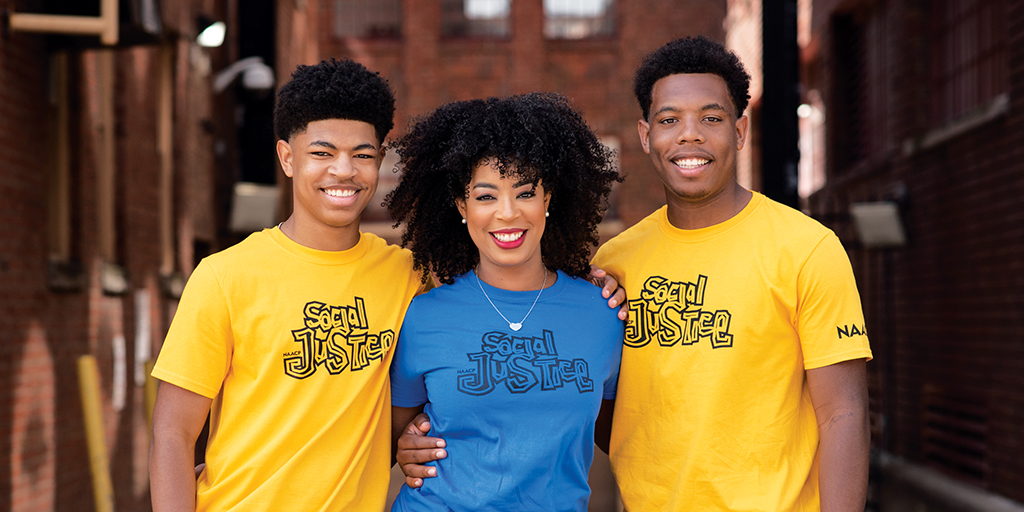
Sydnor had always been acutely aware of the different experiences her children would have in life. The worry of raising two Black sons, 15-year-old Giles and 17-year-old Noah, in a world where racial stereotypes allow people to feel threatened, has always weighed heavy on her shoulders.
“You have to watch the innocence of your Black sons more quickly than what society allows,” says Sydnor. “Individuals will weaponize who they are because of their Black skin.”
In February, after attending a Roddy Ricch concert at the House of Blues downtown, Giles bought a ski mask. Sydnor had a long talk with him about the dangers of wearing it in public.
“You know, he’s a creative, artsy kid,” she says. “He’s wearing it because he thinks it’s cool.”
But in March, Giles shared an article on social media about the death of Elijah McClain. The 23-year-old had been wearing an open-face ski mask in Aurora, Colorado, in August 2019. Within 15 minutes of police responding to a 911 call reporting a “suspicious person,” officers tackled McClain to the ground, put him in a chokehold and called EMS, who injected him with ketamine. On the way to the hospital, McClain had a heart attack and died days later after he was declared brain dead. McClain’s case, which recently attracted renewed scrutiny amid the national conversation around systemic racism and deadly police tactics, embodied Sydnor’s fear.
“I’m trying to use these opportunities as teachable moments but also not force my kids to believe they have to live their life in fear,” says Sydnor.
It’s this need for additional safety for her sons that motivates Sydnor to push for police reform across Cuyahoga County.
One week after George Floyd’s death, organizations such as the Cuyahoga County Police Chiefs Association released a statement denouncing officer Chauvin’s actions and a revived commitment to work with communities who face trepidation with the police. Sydnor saw it as an opportunity for improvement and reached out to meet with CCPCA’s president Michael Cannon.
On June 16, Sydnor sat with Cannon and three other police chiefs with a list of demands passed down from NAACP’s national office.
“We were willing to listen to address anything we could do immediately,” Cannon says.
Sydnor provided five proposals for police reform. Among them, she advocated for a ban of knee holds, chokeholds and other excessive methods of force. She wanted a renewed maintenance of Ohio’s Open Records Law to ensure police reports and documents remain available for the public to view at-will. And she requested a review of recertification credentials and stricter screenings for new recruits.
Sydnor understands her propositions tie directly into Cleveland’s police consent decree, a federal mandate from the U.S. Department of Justice to ensure reforms continue within the Cleveland Police Department. However, NAACP Cleveland is advocating that all Cuyahoga County law enforcement offices adopt a system of uniformity as local departments uphold different policies.
“If my Black son is driving in Shaker [Heights] or Hunting Valley, or Cleveland, I want to know that the department has banned chokeholds, knee holds or that they’re not going to use that kind of policing tactics on him,” says Sydnor. “We are advocating for more cohesiveness.”
As part of an effort to increase accountability and build trust in the community, Cannon offered to maintain calls and meetings with his network to see if the departments are adhering to the decree laws.
“We can reach out to that department and say, ‘Hey, we agreed with the NAACP to work with them on these issues. Here’s what’s happening. What’s going on over there?’ ” Cannon says.
For Sydnor, the meeting was as much about finding a solution as it was about shedding light on the concerns and frustrations community members have had when dealing with the police. Although there were no expectations that possible solutions would be drawn from the meeting, part of Sydnor’s process includes building relationships and identifying ways other groups can get involved in the collective effort of activism.
“When you talk about relationship building, you really need to get a chance to see somebody. Have them feel their vibe and they feel yours,” says Sydnor. “Like much of what we do these days, this is a marathon, not a sprint we are working toward.”
Sydnor’s story about her concern for her son Giles inspired Cannon to pursue change and broadened his perspective as a white cop.
“I can’t pretend to know what it’s like to be a Black guy driving a car,” says Cannon. “If a community says there’s systemic racism in this, then they can’t be wrong. Perception is reality and this is why we’re working to fix these things.”
Since their first meeting, Sydnor and Cannon have struck up an agreement to meet quarterly to discuss any issues that Black residents are facing with police in Cuyahoga County, including access to police records, use-of-force incidents and more.
“These conversations aren’t new to us,” says Cannon. “Nothing gets fixed overnight. But, having an open dialogue, we can bridge that gap between mistrust by people and the police.”
Sydnor is hopeful that this can become a step toward real change. Her plans include formalizing this process and putting it to a vote with her executive committee this fall. Once approved, her team will move forward and seek out other government and local entities who may want to support this effort.
“These moments are asking people to say what their intentions are for the Black community in an effort to decrease the racial divide, disparities and tensions,” says Sydnor. “It’s more than words, it’s through deeds. You cannot do these things alone. We can only achieve [success] if we are doing this type of work together.”
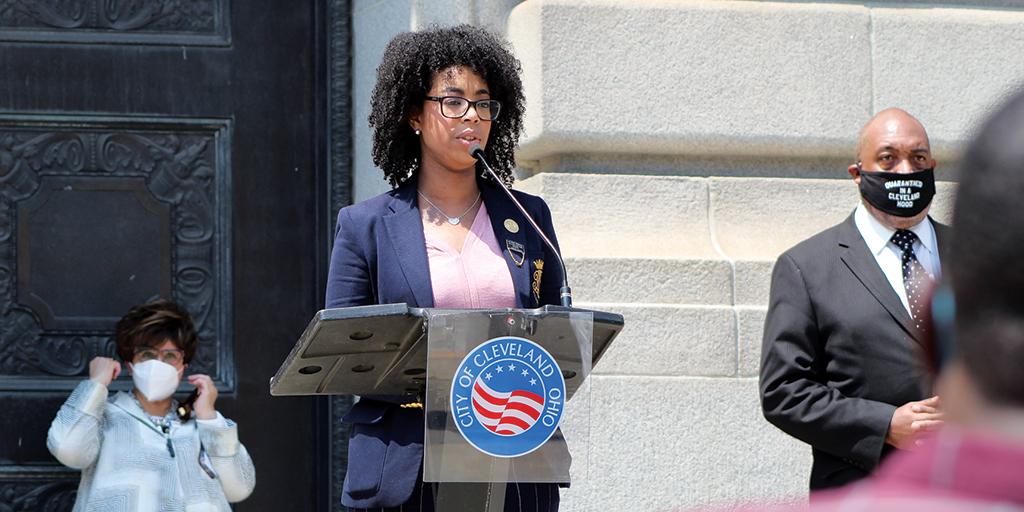
One week before the Fourth of July, Sydnor is a guest on Jeff Dogget’s The Right Side, a weekly digital broadcast segment on Cleveland’s NoStaticRadio. In a third-floor studio on Euclid Avenue, she engages in a 38-minute conversation on the importance of civic advocacy, voter registration for minority communities, the 2020 Census and the importance of political education that everyone must participate in to create change.
“All of these things that happen in society are by the democratic process,” she says, leaning toward the microphone. “So if you want to see change in that system, you have to be able to participate.”
When the interview is over, Sydnor reserves a few minutes to relax on the steps of an abandoned church nearby. In the span of just three weeks, Sydnor has represented NAACP Cleveland in conversations at Cleveland’s City Club, on Zoom panels and more to speak about the movement toward anti-racist policies and practices. Staying present and available for a vulnerable community during a time of high distress can become emotionally taxing, but Sydnor needs to hear how people are responding in this crisis. The input she receives is what is taken with her to those civic meetings, corporate board rooms, those places with powerful people making decisions.
“I’m trying to attract more folks to come work alongside me,” she says.
Her recent push for the “I Got 5 On It” challenge calls for members to inspire five people to complete the census, register to vote and cast a ballot in the upcoming November election. These civic duties, she says, are still central to NAACP Cleveland’s focus.
“I think of these issues like building a house,” she says. “The foundation of all of those issues is economics. The census brings funding into the community. Your vote decides the seat for the candidate in your ward who can advocate for that funding. Economic equality also lends itself to solve for some of the symptoms of poverty like lack of education, violence, health disparities. We will never stop fighting these issues because they are constant.”
As the summer heats up, growing concerns around violence and overcoming obstacles during a global pandemic continue. That tumultuous energy has Sydnor reflecting on her sons and her privilege as a leader.
“I’ve chosen to live in a neighborhood where there are certain things my sons won’t have to deal with, like gun violence and gang violence,” she says. “I still can’t change the fact that when they leave my house every day, they are Black men and are going to be perceived as older or more suspicious than who they are.”
Despite that, she remains hopeful. In the midst of chaos, she motions toward powerful points of light in the community and the modes of resiliency Black people employ that brings her joy. She discusses the Black Lives Matter mural on East 93rd Street, the power of music that pushes people to fight for liberation and how a network of minority-owned small businesses can establish unity. And along the way, she consistently calls back to a mantra she adopted from national NAACP president Derrick Johnson: When we fight, we win.
“We are survivors and thrivers,” says Sydnor. “No one has given us anything freely and they’re never going too. It’s why I fight for these things. In the end, we will win.”
Trending
-
1
-
2
-
3
-
4
-
5



